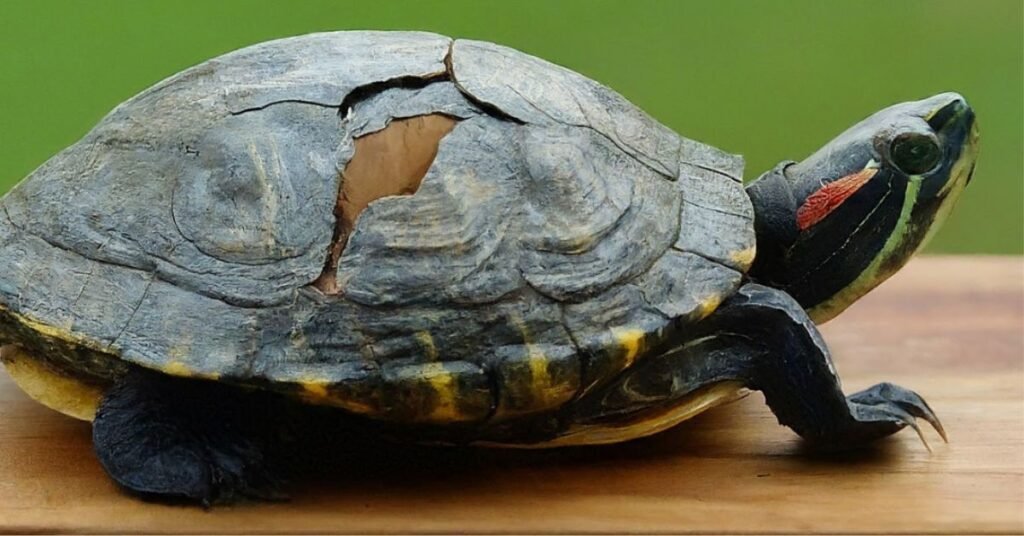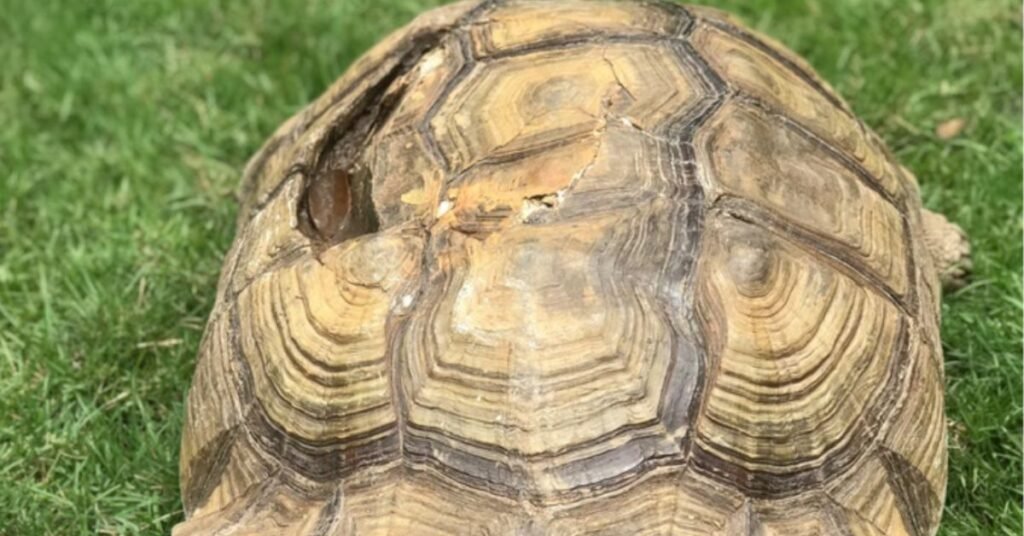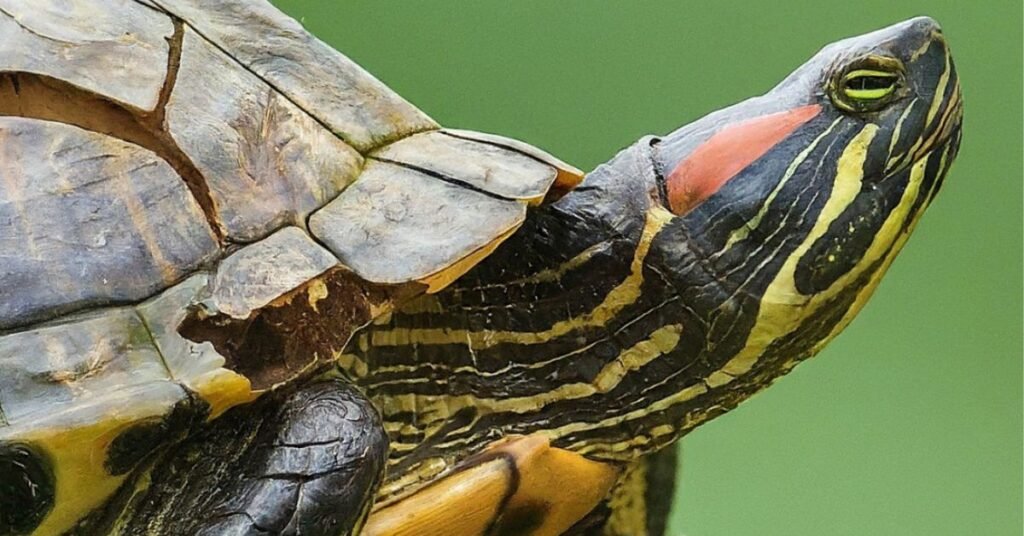When we think about turtles, the first vision that comes to our mind is their hard-armored shell. Almost all turtle species have this shell structure. Because the shell seems hard, many people think it may not be injured. But the truth is that if turtles face any severe accident, like being attacked by a dog or a car accident, their turtles’ shells can get seriously damaged. So, if the shell gets damaged, do turtles’ shells heal?
Well, it depends. If the injury is less or mediocre, the turtle’s shell definitely heals if taken care of properly. However, when you find any turtle with severe damage, like most of the parts cracked or shell pieces are lost, then the hope is low. So, if you are looking for this answer: do turtle shells heal? We will walk you through the details of this question.
Do Turtle Shells Heal?

Yes, turtle shells heal. However, the healing process is gradual and complex, akin to the healing of human bones. Turtles are cold-blooded, so their recovery process can take longer than warm-blooded animals. The healing involves the regeneration of bone and keratin, similar to how human bones mend. Shell fractures may take several months to over a year to heal, depending on the severity of the damage.
Also, healing depends on the severity of the injury. If the damage is too extensive, like broader cracks or loose shell pieces, it may not heal, as we mentioned above. Depending on the situation, cleaning, antibiotics, and even surgery may be needed to ensure proper healing.
Turtle shells are a crucial component of a turtle’s body. They are not just protective armor but integral parts of its skeletal system. Various factors, such as the turtle’s environment and nutrition, play a pivotal role in the healing journey.
Turtle Shell Anatomy
Before knowing about turtles’ shell injury and healing process, we should understand their shell anatomy.
Composition of Bone and Keratin
Turtle shells are fascinating structures composed of both bone and keratin. The shell itself is divided into two main parts: the upper carapace and the lower plastron. These parts are made of bony plates. They connect smoothly with the turtle’s spine and ribs to form a solid protective barrier. Scutes cover these bones with challenging, keratin-based segments. Keratin is the same protein that makes up human hair and nails.
Connection to the Skeletal System
The turtle’s shell is not just an external feature; it’s a crucial part of its skeleton. The carapace and plastron are fused to the turtle’s vertebrae and ribs, making them an integral part of the turtle’s body. Because of this unique adaptation, turtles can withstand various environmental challenges. The shell is part of the turtle’s skeletal system, so damage to it can affect its overall health.
Role of Scutes in Protection and Regeneration
Scutes play a vital role in a turtle’s shell. These keratinous plates overlap each other, protecting the turtle from predators and harsh environments. The scutes also help regenerate the shell. Whenever a turtle gets injured, new scutes form slowly, replacing damaged ones and restoring its integrity. In the wild, turtles need this regenerative ability to survive. Each turtle species has different patterns of scutes that serve as a defense mechanism and camouflage.
How Turtle Shell Heals?

Here’s the turtle shell healing process –
Natural Healing Capabilities
When a turtle’s shell gets injured, the bone underneath starts to heal first. After that, new protective layers, called scutes, begin to grow. These scutes are like little shields made of keratin.
A turtle’s shell has 13 big scutes on top and 28 smaller ones around the edges. Over time, the damaged piece of bone gets pushed out and eventually falls off. Turtle shells have an incredible ability to heal themselves.
Slow Regeneration Process
Regenerating a turtle’s shell is a slow journey. Like bone healing in humans, this process involves rebuilding the damaged areas over months or even years. It’s a meticulous task that requires the right conditions, the proper veterinarian treatment, and care to ensure successful recovery.
Role of Osteoblasts in New Bone Formation
Osteoblasts in a turtle’s shell are cells responsible for bone formation. They help form new bone by depositing minerals and creating a scaffold for bone regeneration. This process is essential for repairing fractures and strengthening the shell’s structure.
Regeneration of Scutes Through Fibroblasts
Fibroblasts are another kind of cells that play a vital role in scute regeneration. These cells produce connective tissue that helps form new scutes. It is the tough, protective outer layer of the shell. They ensure that the regenerated shell is as resilient as the original.
Factors Influencing Healing Time
Several factors can affect the healing time of a turtle’s shell. In order to recover faster, it’s crucial to have a clean, safe environment. Nutrition is also essential since vitamins and minerals aid in healing. Lastly, the severity of the damage affects how quickly a turtle can recover. Severe injuries may need more time and veterinary care.
Why Do Turtle Shells Get Damaged?

So, what are the reasons for turtles’ shell injury? To avoid injury, people should be careful to take care of these causes –
Human Activities Like Car Accidents
Human actions pose significant threats to turtle shells. Road traffic is a major cause of shell damage; turtles crossing roads are often hit by vehicles. If you handle your turtle roughly and drop it from above, the shell can be damaged. Turtles are sometimes accidentally harmed by fishing equipment or litter, like plastic rings that restrict growth and movement.
Pet Attack (Like dog)
Turtle shell damage often happens when pets like dogs attack them. These attacks can break or crack the shell. There are many cases where we see pet turtles get attacked by pet dogs in a severe state. When turtles are left outside, especially during summer, without someone watching, the chance of them getting attacked is high.
Environmental Factors
Various environmental conditions can damage turtle shells. Harsh weather and natural disasters, like storms or floods, can harm their habitats, leading to an increased risk of injury. For instance, strong currents in rivers can push turtles against rocks, causing shell fractures.
Natural Predators In Wild
Predators also contribute to shell damage. Animals such as raccoons and birds may attempt to break the shell to reach the turtle inside. While natural predation is part of the ecosystem, it can lead to severe injuries for turtles, especially young ones with softer shells.
Examples and Stat
Statistics show that road vehicles are responsible for a significant number of turtle injuries each year. For example, in some areas, 100 turtles are admitted to wildlife hospitals annually due to vehicle-related shell damage.
How To Treat a Damaged Turtle Shell
So, if you see any turtle shell injured, what would you do? Let’s see –
First, Monitor and Cleaning
When a turtle shell is damaged, the first step is to assess the injury. Look for cracks, bleeding, or exposed tissue. Then, you should clean the wound gently using warm water and mild antiseptic to prevent infection. This first aid is crucial for any minor injury to prepare the shell for further treatment.
For Severe Injury, Take Veterinary Assistance
Professional veterinary care is essential for severe shell injuries. Veterinarians can assess the extent of damage, remove dead tissue, and set broken bones. They often use bone cement and systemic antibiotics to aid healing. A vet’s expertise ensures the turtle receives the best care possible.
DIY Home Care for Minor Cracks
Home care can be effective for minor shell cracks. Clean the area thoroughly and apply an antibacterial ointment like Neosporin. Keep the turtle dry and monitor it closely for signs of infection. Small cracks often heal with proper care and attention.
Use of Antiseptics and Fiberglass Patches
Antiseptics help ward off infection in damaged shells. Fiberglass patches can provide support for larger cracks. After cleaning and drying the shell, apply the patch securely over the crack. This method stabilizes the shell while it heals.
Keeping the Turtle Dry and Providing Antibiotics
Keeping the turtle dry is essential to prevent further damage and infection. Use a shallow container that only covers the turtle’s feet with water. If the injury is severe, antibiotics might be necessary. You should consult a vet for the appropriate medication.
Professional Repair Techniques
For more complex repairs, professionals may use wiring or epoxy applications. Wiring stabilizes severe fractures, while epoxy can fill gaps and strengthen the shell. These techniques require precision and should be performed by someone experienced in turtle care.
Prevention Strategies for Shell Damage
Prevention is always better than afterward suffering. Here’s how you should take care to prevent turtle shell damage
Providing a Safe and Clean Environment
It’s essential to keep turtles in a clean and safe environment. Their habitat should be free of sharp objects or hazards that could damage their shells. Clean the enclosure regularly to prevent bacteria from accumulating, which can cause shell rot. A well-maintained habitat is the first line of defense against shell damage.
Ensuring a Proper Diet Rich in Calcium and Vitamins
A balanced diet is crucial for maintaining a turtle’s shell health. For a strong shell, make sure your turtle eats calcium-rich foods like leafy greens and calcium supplements. Vitamins, especially vitamin D, are also crucial as they help absorb calcium, promoting a resilient shell structure.
Avoiding Rough Handling and Ensuring Secure Enclosures
Turtles are delicate creatures and should be handled gently. Avoid rough handling that can cause stress or accidental injury to their shells. Additionally, secure enclosures are vital in preventing escapes and potential falls or injuries. Make sure the enclosure is escape-proof and provides ample space for the turtle to move around safely. Also, you should take care of your pet dog if you have one because, many times, a pet dog attack can result in a turtle shell injury.
Regular Veterinary Check-Ups for Overall Health
Not only for shell injury, regular veterinary check-ups are essential to catch any potential health issues early. A vet can assess your turtle’s overall health, including its shell condition, and recommend any necessary treatments or dietary adjustments. Routine visits can help you to ensure your turtle remains healthy and robust.
FAQs
Do Turtle Shells Heal If Cracked?
Yes, turtle shells can heal if cracked, but the process requires time and proper care. Turtle shells are made of a bony structure covered by scutes, which can regenerate similarly to human bones. Minor cracks often heal on their own if the turtle is kept in a clean and safe environment.
Can Broken Turtle Shells Heal?
Yes, turtle shells can heal. Like human bones, their shells are composed of bone and keratin. In cases of severe fractures, professional veterinary care is essential. Vets might use techniques like wiring or applying special adhesives to hold shell pieces in place to connect broken parts.
Can a turtle’s shell regrow/regenerate?
The ability of turtle shells to regenerate is limited. If a turtle’s shell is destroyed, it cannot fully regenerate like lizards’ tails. However, if the damage is minor, such as small cracks or chips, the shell can heal over time with the proper care. This healing process involves the regrowth of scutes, the outer layer of the shell, which can take months to years.
Read More: How To Clean A Turtle Shell
Conclusion
Turtle shells are incredibly resilient, so they will heal gradually. Yet, their health depends significantly on our care. Safe environments, balanced diets, and timely treatments are crucial to supporting their well-being. Regular vet check-ups are vital in catching issues early. Let’s be proactive in protecting our turtles, helping them lead long and healthy lives.
